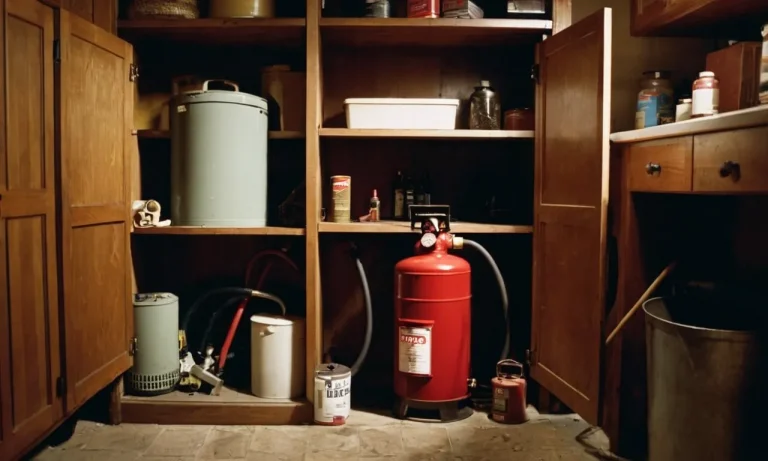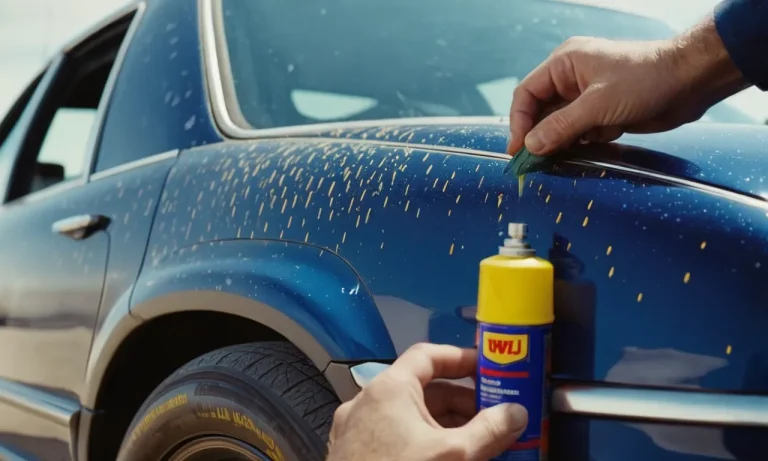Can You Paint Over Semi-Gloss Paint?
If you’re looking to change up the look of a room with a fresh coat of paint, you may be wondering if you can paint over existing semi-gloss paint. The short answer is yes, you can paint over semi-gloss with the proper preparation and paint products.
Read on for a more in-depth look at how to successfully paint over semi-gloss paint.
Painting over semi-gloss paint is possible with proper preparation. Sanding, priming, and using paint designed for glossy surfaces will allow the new paint to adhere. Test paint adhesion on a small area first.
What is Semi-Gloss Paint?
Semi-gloss paint is a type of paint that has a distinctive sheen level. It falls between the high sheen of gloss paint and the low sheen of satin or eggshell paint. The sheen level of semi-gloss paint gives it a reflective and shiny finish, making it a popular choice for many different applications.
Sheen Level
The sheen level of semi-gloss paint is often described as being between 35 to 70 percent. This means that the paint has a moderate to high level of shine, which can enhance the appearance of surfaces. The higher the sheen level, the more light the paint reflects, creating a bright and vibrant look.
Uses and Benefits
Semi-gloss paint has various uses and benefits that make it a preferred choice for many homeowners and professionals. Its durability and resistance to moisture and stains make it ideal for high-traffic areas like kitchens, bathrooms, and hallways.
It is also commonly used for trim, doors, and cabinets due to its ability to withstand frequent cleaning.
Additionally, semi-gloss paint is known for its smooth and even finish, which helps to hide imperfections on the surface. It can also make a small room appear larger by reflecting light and creating an illusion of space.
Drawbacks
While semi-gloss paint has many advantages, it is important to consider its drawbacks as well. The high sheen of semi-gloss paint can highlight any surface imperfections, such as dents or scratches. Therefore, proper surface preparation is crucial before applying this type of paint.
Furthermore, semi-gloss paint is more challenging to touch up compared to flat or satin paint finishes. It requires careful blending to ensure a seamless appearance. If touch-ups are not done correctly, they may result in noticeable variations in sheen and color.
Can You Paint Over Semi-Gloss?
Semi-gloss paint is a popular choice for many surfaces due to its durability and shiny finish. However, there may come a time when you want to change the color or texture of a surface that has been previously painted with semi-gloss.
The good news is that, with proper preparation, you can indeed paint over semi-gloss paint.
Yes, with Proper Preparation
Before you start painting over semi-gloss, it’s important to prepare the surface properly. This will ensure that the new paint adheres well and provides a smooth and even finish. Here are some steps to follow:
- Clean the surface: Use a mild detergent and water to remove any dirt, grease, or grime from the surface. Rinse it thoroughly and allow it to dry completely.
- Sand the surface: Lightly sand the semi-gloss paint to create a rough surface that the new paint can adhere to. Use a fine-grit sandpaper and work in circular motions. Remember to wear a mask and goggles to protect yourself from dust.
- Prime the surface: Apply a coat of primer to the sanded surface. Primer helps to create a smooth base for the new paint and improves its adhesion. Choose a primer that is specifically designed for the type of surface you are painting.
- Paint: Once the primer is dry, you can proceed with painting the surface. Use a high-quality paint that is suitable for the type of surface and finish you desire. Apply thin and even coats, allowing each coat to dry before applying the next.
By following these steps, you can successfully paint over semi-gloss paint and achieve the desired results.
Improper Preparation Issues
If you fail to properly prepare the surface before painting over semi-gloss paint, you may encounter some issues. These can include:
- Poor adhesion: Without proper cleaning and sanding, the new paint may not adhere well to the semi-gloss surface, resulting in peeling or flaking over time.
- Uneven finish: Skipping the primer step can lead to an uneven finish, with the new paint appearing blotchy or streaky.
- Longer drying time: If the surface is not properly cleaned or sanded, the new paint may take longer to dry, leading to extended waiting times between coats.
Remember, proper preparation is key when painting over semi-gloss paint. Take the time to clean, sand, and prime the surface, and you’ll be rewarded with a beautiful and long-lasting finish.
How to Prepare Semi-Gloss for Painting
If you’re looking to update the look of a room or piece of furniture, you may be wondering if you can paint over semi-gloss paint. The good news is that with proper preparation, you can successfully paint over semi-gloss paint and achieve a smooth, professional finish. Here are some steps to follow:
Clean the Surface
Before painting over semi-gloss paint, it’s important to clean the surface thoroughly. Use a mild detergent and warm water to remove any dirt, grease, or grime. Make sure to rinse the surface well and allow it to dry completely before moving on to the next step.
This will help ensure proper adhesion of the new paint.
Sand the Semi-Gloss
Next, you’ll want to lightly sand the semi-gloss paint to create a rougher surface for the new paint to adhere to. Use a fine-grit sandpaper and gently sand the surface in a circular motion. Be careful not to sand too aggressively, as this can damage the underlying surface.
Once you’ve finished sanding, wipe away any dust with a damp cloth.
Spot Prime Bare Areas
If you notice any bare areas or areas where the semi-gloss paint has been worn away, it’s important to spot prime these areas before painting. Spot priming helps to ensure that the new paint will adhere properly and provide an even finish.
Use a high-quality primer and apply it to the bare areas using a brush or roller. Allow the primer to dry completely before moving on to the next step.
Once you’ve completed these steps, you’re ready to paint over the semi-gloss paint. Choose a high-quality paint in the desired color and apply it using a brush or roller. Apply multiple thin coats, allowing each coat to dry before applying the next.
This will help you achieve a smooth, professional finish.
Remember, proper preparation is key when painting over semi-gloss paint. By cleaning the surface, sanding the semi-gloss, and spot priming any bare areas, you can ensure that your new paint will adhere properly and provide a beautiful, long-lasting finish.
Choosing the Right Paint
When it comes to repainting a room or a piece of furniture, choosing the right paint can make all the difference in achieving the desired results. One of the common dilemmas homeowners face is whether they can paint over semi-gloss paint.
Understanding the different types of paint and their sheen compatibility is crucial for a successful and long-lasting paint job.
Latex or Oil-Based
Before deciding on the sheen of the paint, it’s important to determine whether you should use latex or oil-based paint. Latex paint is water-based and dries quickly. It is also more environmentally friendly and has less odor compared to oil-based paint.
On the other hand, oil-based paint provides a smoother finish and is more durable, making it ideal for high-traffic areas or surfaces that require frequent cleaning.
Sheen Compatibility
Once you’ve decided on the type of paint, you need to consider the sheen compatibility. Sheen refers to the level of shine or glossiness of the paint. Common sheen options include flat, matte, eggshell, satin, semi-gloss, and high-gloss.
When it comes to painting over semi-gloss paint, it’s important to ensure that the new paint is compatible with the existing sheen.
Generally, it is possible to paint over semi-gloss paint with a different sheen. However, it is recommended to lightly sand the surface and apply a primer before applying the new paint. This will help create a smooth and even surface for the new paint to adhere to.
Additionally, using a primer can help prevent the new paint from peeling or chipping over time.
Higher Sheen for Easier Coverage
If you are looking for an easier coverage and a more forgiving finish, choosing a higher sheen paint can be beneficial. Higher sheen paints, such as semi-gloss or high-gloss, tend to have better hiding capabilities and can help mask imperfections on the surface.
This can be especially useful when painting over a surface with existing flaws or when covering a dark-colored paint.
However, it’s important to note that higher sheen paints also tend to highlight any imperfections or unevenness in the surface. Therefore, proper surface preparation, including sanding and priming, is still crucial for achieving a smooth and professional-looking finish.
Remember, it’s always a good idea to consult with a professional painter or refer to reputable sources, such as Benjamin Moore or Sherwin-Williams, for specific product recommendations and guidelines for painting over semi-gloss paint or any other paint-related questions you may have.
Application Tips and Tricks
Painting over semi-gloss paint can be a bit tricky, but with the right techniques, it is definitely possible to achieve a smooth and professional finish. Here are some useful tips and tricks to keep in mind:
Apply in Multiple Thin Coats
When painting over semi-gloss paint, it’s important to apply the new paint in multiple thin coats rather than one thick coat. This allows for better adhesion and minimizes the risk of drips or streaks.
Start with a primer to create a smooth surface for the new paint to adhere to, and then apply two or three thin coats of your desired paint color. This will ensure an even and long-lasting finish.
Use Proper Brush or Roller
The type of brush or roller you use can make a significant difference in the final result. For painting over semi-gloss paint, it’s generally recommended to use a high-quality synthetic brush or a foam roller. These tools provide better control and help to achieve a smoother finish.
It’s also important to choose the appropriate size brush or roller for the size of the area you are painting. This will make the application process easier and more efficient.
Check Paint Adhesion
Prior to painting over semi-gloss paint, it’s essential to check the adhesion of the existing paint. This can be done by performing a simple tape test. Apply a piece of painter’s tape to the painted surface and firmly press it down. Then, quickly peel it off.
If the tape lifts off any paint, it indicates poor adhesion, and you may need to sand the surface lightly or use a bonding primer before applying the new paint. Ensuring good paint adhesion will help prevent peeling or chipping in the future.
Remember, each painting project is unique, and it’s always a good idea to consult the manufacturer’s instructions and recommendations specific to the paint you are using. By following these application tips and tricks, you’ll be on your way to achieving a beautiful and durable finish when painting over semi-gloss paint.
Conclusion
Painting over semi-gloss paint is definitely possible with some preparation. Following the steps to properly clean, scuff, prime, and apply paint designed for glossy surfaces will allow the new paint to adhere smoothly and evenly.
Be sure to test paint adhesion and apply multiple thin coats for best coverage. With the right steps, you can easily update the look of your space by painting over existing semi-gloss paint.







